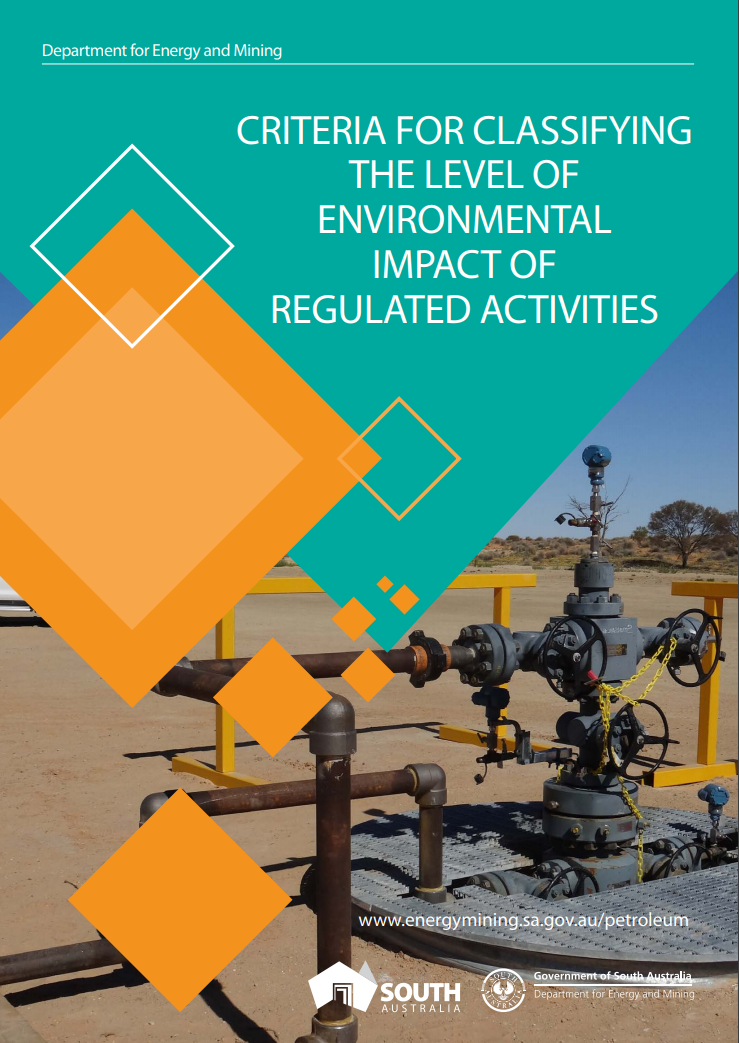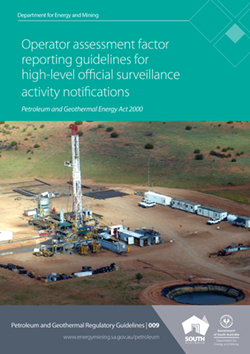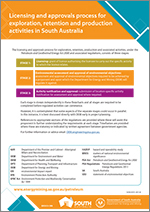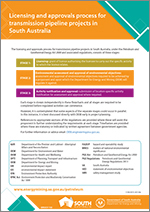Update 11 April 2024 – Legislation has been amended
Please refer to current legislation Energy Resources Act 2000 and Energy Resources Regulations 2013.
The amended legislation supersedes the Petroleum and Geothermal Act 2000 and Petroleum and Geothermal Energy Regulations 2013.
Guidelines and policies have yet to be reviewed in accord with the amended legislation, any updates of these documents will be advised accordingly.
For further information please contact DEM.Petroleum@sa.gov.au
On this page
The Petroleum and Geothermal Energy Act 2000 licensing and approvals process consists of three stages:
- Stage 1 - Licensing
- Stage 2 - Environmental assessment and approval of Environmental Objectives
- Stage 3 - Activity notification and approval
The steps involved in the three stages of the activity approvals process are characterised by the particular activity being proposed. The activity approvals process is divided into two types; the general activity approvals process, which includes exploration, retention, production and associated activities, and the pipeline activity approvals process which includes transmission pipeline projects.
The steps involved in the exploration, retention, production and associated activities approval processes and steps involved in a transmission pipeline project activity approval process are detailed in the following flow-charts:
Stage 1 - Licensing
For detailed information on the processes and requirements of obtaining a licence under the Petroleum and Geothermal Energy Act 2000, see how to apply for a licence.
Stage 2 - Environmental assessment and approval of Environmental Objectives
Environmental Impact Report
In accordance with Section 97 of the Petroleum and Geothermal Energy Act 2000, Licensees are required to prepare an Environmental Impact Report for proposed regulated activities. This document addresses the potential threats and risks on the environment, and outlines the extent to which these threats are likely and manageable.
Under Regulation 10 of the Petroleum and Geothermal Energy Regulations 2013 the Environmental Impact Report is required to provide the following information:
- a description of the activities to be carried out;
- a description of the specific features of the natural, social/cultural and economic aspects of the environment which may be affected by the activities;
- a description of the actual and potential events associated with the activities that could pose a threat to the various aspects of the environment (as per definition of environment provided in Section 4 of the Petroleum and Geothermal Energy Act 2000) including the likelihood of the events and the level of certainty in their prediction;
- an assessment of the potential consequences of the above defined events on the various aspects of the environment;
- detailed information on the extent to which the above potential consequences can be managed including information on their duration, size and scope; and
- information on any consultation undertaken with the relevant land owner or occupier, relevant government agencies or other interested groups or individuals.
The information and material provided by the Environmental Impact Report must:
- be balanced, objective and concise;
- state any limitations that apply, or should apply, to the use of the information and material;
- identify any area or issue in relation to which there is a significant lack of relevant information or a significant degree of uncertainty;
- identify the sensitivity to change of any assumption that has been made and any significant risks that may arise if an assumption is later found to be incorrect; and
- be presented in a way that allows a person assessing the information or material to understand how conclusions have been reached and allows the information or material to be used to make an informed decision on the level of environmental impact of a particular activity without the need to obtain additional technical advice.
Current and archived Environmental Impact Reports are available on the Environmental Register.
Statement of Environmental Objectives
A Statement of Environmental Objectives (SEO) is developed through an open, consultative process, based on information provided in the Environmental Impact Report. A Statement of Environmental Objectives may relate to either a specific activity carried out at a specific location; or a particular activity type (e.g. drilling, seismic activities, the construction and operations of facilities and pipelines) carried out within a specific region or land system.
For the purposes of the Petroleum and Geothermal Energy Act 2000 the definition of environment includes the natural, social, cultural and economic aspects of the area, locality or region.
A Statement of Environmental Objectives for a regulated activity must state the environmental objectives to be achieved in carrying out the specified activities, as well as the assessment criteria used to assess whether the objectives have been achieved by the licensee.
A Statement of Environmental Objectives must include objectives that relate to:
- construction activities;
- operational activities;
- emergency response and management;
- rehabilitation in cases involving a serious or reportable incident under Section 85 of the Petroleum and Geothermal Energy Act 2000;
- decommissioning, abandonment and rehabilitation; and
- dealing with the consequences of events associated with the relevant activities on the various aspects of the environment.
A Statement of Environmental Objectives must also include conditions and requirements for achieving the stated objectives, such as incident reporting requirements. For some objectives, which cannot readily be measured through quantitative assessment, particularly in relation to land and vegetation disturbances such as the restoration of well sites and seismic lines, techniques such as Goal Attainment Scaling have been adopted to provide such measurement. Guidelines outlining this process are under Policies and Guidelines.
These features of a Statement of Environmental Objectives provide transparency to stakeholders on what is required of the licensee in terms of its environmental performance.
It is a requirement, under Regulation 14 of The Petroleum and Geothermal Energy Act 2000, that a Statement of Environmental Objectives will be reviewed at least once in every 5 years. If this review identifies that a revision of the document is required, the document will be revised by the Minister (or cause the revision to be undertaken by the licensee) and then the statement is submitted for consideration under the Petroleum and Geothermal Energy Act 2000.
The performance of the licensee against the Statement of Environmental Objectives will be publicly disclosed annually on the Environment Register, in addition to the provision of Environmental Impact Reports, Statement of Environmental Objectives and details of the Minister's determination of the level of impact of all proposals.
Current and archived Statement of Environmental Objectives are available on the Environmental Register.
Impact Classification
On the basis of the information provided in the Environmental Impact Report and in accordance with Section 98 of the Petroleum and Geothermal Energy Act 2000, the Minister, using a set of publicly developed and disclosed criteria, must classify the level of impact of any proposed activity.
 The Criteria for Classifying the Level of Environmental Impact of Regulated Activities outlines the criteria upon which the level of impact of a regulated activity will be assessed and subsequently classified. Guidelines for the application of these criteria are also included.
The Criteria for Classifying the Level of Environmental Impact of Regulated Activities outlines the criteria upon which the level of impact of a regulated activity will be assessed and subsequently classified. Guidelines for the application of these criteria are also included.
The classification will either be low, medium or high and will be made in consultation with other relevant Government departments.
These consultation protocols have been established under various administrative agreements between the Energy Resources Division and these departments. Copies of administrative arrangements currently in place are available.
The requirement for a period of public consultation is determined by the classified level of impact of the proposed activity on the basis of a set of publicly developed and disclosed criteria for making such a determination.
Low Impact Activity Assessment Process
The Department undertakes consultation internally with Government agencies including the Department of Environment and Water, the Environment Protection Authority and, if relevant, the Department of Planning, Transport and Infrastructure, and SafeWork SA. Government consultation protocols and time frames are determined through administrative arrangements between the Energy Resources Division and the specific agency.
Medium Impact Activity Assessment Process
Where an activity is classified as medium impact it will follow the public assessment process described under section 101 in the Petroleum and Geothermal Energy Act 2000. The Energy Resources Division seeks community comment through a public consultation period, which is required to run for at least 30 business days. Additionally, the Energy Resources Division may invite submissions from organisations and/or persons who have particular interest in the area or region which is likely to be affected by the proposed activity.
All submissions on the Environmental Impact Report and draft Statement of Environmental Objectives made to the Energy Resources Division are kept available for public inspection on the Environment Register. The proponent is then required to address the issues raised by public submission/s and revise the Environmental Impact Report and draft Statement of Environmental Objectives accordingly, where required.
The Department reviews the revised versions of the Environmental Impact Report and Statement of Environmental Objectives and if the Environmental Impact Report and Statement of Environmental Objectives have been amended substantially, as a result of the public submissions, the Energy Resources Division will require the consultation process to be repeated.
High Impact Activity Assessment Process
If a project is assessed as having a high environmental impact, the proposal is referred to the Minister responsible for the Planning, Development and Infrastructure Act 2016 for an Environment Impact Assessment under Part 12 of that Planning, Development and Infrastructure Act 2016.
Consultation
A proponent must consult with all relevant stakeholders during the project planning stage. The extent of consultation undertaken during this phase is a critical factor considered by the Energy Resources Division in determining the environmental impact classification.
The Energy Resources Division encourages the use of the Ministerial Council on Mineral and Petroleum Resources (MCMPR) endorsed guide located in Policies and Guidelines. This document sets out the key principles for effective liaison between the resource sector, the community and various stakeholders.
The level of consultation undertaken by the Department during the assessment and approval process for a proposed activity is determined by the impact classification. In the instance where an activity involves a Coal Seam Gas project, the project will be referred to the Independent Expert Scientific Committee to be part of the consultation process to align with the National Partnership Agreement (NPA) and SA protocol for IESC referral process.
Stage 3 - Activity notification and approval
In accordance with Regulations 18 and 19, licensees are required to notify, and where relevant, seek approval from the Minister through the Energy Resources Division prior to commencing any regulated activity within a licence area. The activity notification requirements for activities classified as requiring low level official surveillance and those classified as requiring high level official surveillance differ by the amount of information provided and the time frame it is provided in.
As part of its assessment, the Energy Resources Division will also advise licensees whether additional approvals from co-regulatory agencies are required in relation to specific activities.
Low level official surveillance activities (Regulation 18)
An activity notification for an activity classified as requiring low level official surveillance must, pursuant to the requirements of Regulation 18, be submitted to the Energy Resources Division at least 21 days before the proposed commencement date of the activity. As long as no landowner objections are received by the Minister, and the application is compliant, activities can commence at the end of the 21 day period.
This notification must be accompanied by information to satisfy Regulation 20.
High level official surveillance activities (Regulation 19)

This notification must be accompanied by information to satisfy Regulation 20.
Subregulation 19(2)(a) specifies that activity notifications for high level official surveillance activities must also include detailed information on the licensee’s proposals in respect of the operator assessment factors, outlined in Regulation 16. ERD have prepared operator assessment factor reporting guidelines for high-level official surveillance activity notifications to aid licensees in satisfying these requirements.
High level official surveillance activities require Ministerial approval prior to commencement.
Detailed activity information (Regulation 20)
Activity notifications for all activities whether classified as requiring high or low level official surveillance, are required to include or be accompanied by information and material specific to the proposed activity pursuant to various sections of the Petroleum and Geothermal Energy Act 2000 and associated regulations. The Energy Resources Division have provided guidance on the requirements for activity notifications in the Activity Notification Checklist.
Of particular note, with respect to environmental reporting obligations under subregulation 20(1)(g), an assessment is required to be provided by the licensee determining whether the proposed activity is covered by an existing and approved Statement of Environmental Objectives, in addition to detailing how the licensee will ensure that the proposed activity will satisfy the respective Statement of Environmental Objectives requirements.
More information on high and low level official surveillance classification.
Notice of entry
In addition to the stakeholder consultation requirements in the preparation and approval of the Statement of Environmental Objectives, licensees are obliged under Part 10 of the Petroleum and Geothermal Energy Act 2000 to give notices of entry to all landowners 21 days prior to entering and commencing any activity on any land.
In accordance with the requirements of Regulation 22 of the Petroleum and Geothermal Energy Regulations 2013 the notice of entry must contain:
- a detailed description of what will be undertaken
- sufficient information to enable the landowner to reach an informed decision about the impacts and potential impacts the activities will or may have on the land
- sufficient information on the use and/or consequential loss of use of the land by the landowner resulting from the activities.
Furthermore, Part 10 of the Petroleum and Geothermal Energy Act 2000 provides landowners with the right to object to entry within 14 days and to seek any compensation for loss of use or damage or potential loss of use or damage to the land.
Notice of entry templates (Regulation 22)
Notice of entry for preliminary petroleum exploration activities is primarily aimed at providing the Department of Environment and Water with appropriate notification for reconnaissance surveys and for Work Area Clearance activities, for native title or heritage purposes and environmental surveys within regional reserves.
Notice of Entry for all petroleum activities is primarily aimed at providing detailed information to landowners as required by Regulation 22 of the Petroleum and Geothermal Regulations 2013.
The Liaison guidelines for landowners and petroleum and geothermal energy explorers in South Australia is a guide to establishing and maintaining good relations between the petroleum industry and land owners, occupiers and titleholders.




